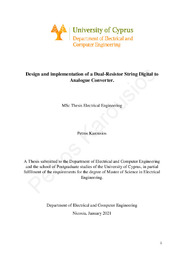Design and implementation of a Dual-Resistor String Digital to Analogue Converter

View/
Date
2021-01-29Author
Karousios, Petros N.Publisher
Πανεπιστήμιο Κύπρου, Πολυτεχνική Σχολή / University of Cyprus, Faculty of EngineeringPlace of publication
CyprusGoogle Scholar check
Keyword(s):
Metadata
Show full item recordAbstract
Analogue to Digital and Digital to Analogue converters have been around for many years, enabling engineers to manipulate electrical signals. These devices are in almost all electronic devices from washing machines to audio amplifiers. For example, in a biochemistry analyzer there is need to convert the analogue voltage from a photodiode into digital signal, in order to represent the result into numbers. In recent years, the constant scaling down of the fabrication technologies, have enabled engineers to improve converters’ characteristics such as area, power consumption and latency. By improving converters’ characteristics, more demanding problems can be tackled easier.
This thesis work aims to introduce to the reader the different types of architectures and their operation alongside with their advantages and disadvantages. Additionally, it focuses on the design, implementation and testing of an 8-bit Dual-Resistor String Digital to Analogue Converter. The converter was designed using Cadence Virtuoso software and was fabricated by using Taiwan Semiconductor Manufacturing Company (TSMC) 180nm technology with 1.8V supply voltage. The purpose of this converter is to drive high impedance loads such as MOSFET-based varistors or varactors of programmable Metasurfaces. After fabrication and testing, the overall results are INL and DNL less than 0.25 LSB with power consumption less than 42.5μW.
